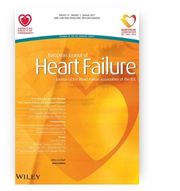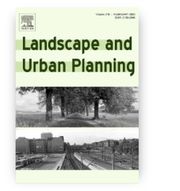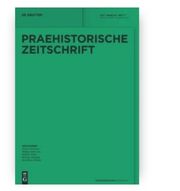
Research papers of the month – December 2021
We present the highest-score research papers of December 2021. These papers have ben published in journals with the highest Ministerial score – 200 points.
Iron deficiency contributes to resistance to endogenous erythropoietin in anaemic heart failure patients
Michał Tkaczyszyn, Josep Comin-Colet, Adriaan A. Voors, Dirk J. van Veldhuisen, Cristina Enjuanes, Pedro Moliner, Marcin Drozd, Radosław Sierpiński, Piotr Rozentryt, Jolanta Nowak, Tomasz Suchocki, Waldemar Banasiak, Piotr Ponikowski, Peter van der Meer, Ewa A. Jankowska
European Journal of Heart Failure
Ministerial score = 200.0
JIF Impact Factor (2020) = 15.534 (Q1)
 Aims: Abnormal endogenous erythropoietin (EPO) constitutes an important cause of anaemia in chronic diseases. We analysed the relationships between iron deficiency (ID) and the adequacy of endogenous EPO in anaemic heart failure (HF) patients, and the impact of abnormal EPO on 12-month mortality. Methods and results: We investigated 435 anaemic HF patients (age: 74 ± 10 years; males: 60%; New York Heart Association class I or II: 39%; left ventricular ejection fraction: 43 ± 17%). Patients with EPO higher than expected for a given haemoglobin were considered EPO-resistant whereas those with EPO lower than expected - EPO-deficient. ID was defined as serum ferritin <100 µg/L or 100–299 µg/L with transferrin saturation <20%. EPO-resistant patients (22%) had more advanced HF whereas those with EPO deficiency (57%) were more frequently females and had worse renal function. Lower serum ferritin (indicating depleted body iron stores) was related to higher EPO observed/predicted ratio when adjusted for significant clinical confounders, including C-reactive protein. One year all-cause mortality was 28% in patients with EPO resistance compared to 17% in patients with EPO deficiency and 10% in patients with adequate EPO (log-rank test for the comparison EPO resistance vs. adequate EPO: P = 0.02). When adjusted for other prognosticators, there was still a trend towards increased 12-month mortality in patients with higher EPO level. Conclusion: Anaemic HF patients with endogenous EPO deficiency vs. resistance have different clinical and laboratory characteristics. In such patients, ID contributes to EPO resistance independently of inflammation.
Aims: Abnormal endogenous erythropoietin (EPO) constitutes an important cause of anaemia in chronic diseases. We analysed the relationships between iron deficiency (ID) and the adequacy of endogenous EPO in anaemic heart failure (HF) patients, and the impact of abnormal EPO on 12-month mortality. Methods and results: We investigated 435 anaemic HF patients (age: 74 ± 10 years; males: 60%; New York Heart Association class I or II: 39%; left ventricular ejection fraction: 43 ± 17%). Patients with EPO higher than expected for a given haemoglobin were considered EPO-resistant whereas those with EPO lower than expected - EPO-deficient. ID was defined as serum ferritin <100 µg/L or 100–299 µg/L with transferrin saturation <20%. EPO-resistant patients (22%) had more advanced HF whereas those with EPO deficiency (57%) were more frequently females and had worse renal function. Lower serum ferritin (indicating depleted body iron stores) was related to higher EPO observed/predicted ratio when adjusted for significant clinical confounders, including C-reactive protein. One year all-cause mortality was 28% in patients with EPO resistance compared to 17% in patients with EPO deficiency and 10% in patients with adequate EPO (log-rank test for the comparison EPO resistance vs. adequate EPO: P = 0.02). When adjusted for other prognosticators, there was still a trend towards increased 12-month mortality in patients with higher EPO level. Conclusion: Anaemic HF patients with endogenous EPO deficiency vs. resistance have different clinical and laboratory characteristics. In such patients, ID contributes to EPO resistance independently of inflammation.
DOI:10.1002/ejhf.2253
READ THE PAPER UPWr Base
Important places in landscape – investigating the determinants of perceived landscape value in the suburban area of Wrocław, Poland
Iga Solecka, Tiina Rinne, Martins Rodrigo Caracciolo, Marketta Kytta, Christian Albert
Landscape and Urban Planning
Ministerial score = 200.0
JIF Impact Factor (2020) = 6.142 (Q1)
 Landscape planning studies usually consider landscape values through expert assessments of landscape aesthetic quality. Combining such expert assessments with people’s perceptions as derived from citizen-based approaches is advisable, but scientific knowledge gaps exist regarding explanatory variables of perceived landscape values. This study aims to investigate determinants of landscape value as perceived by citizens. The suburban area of Wroclaw, Poland serves as an illustrative case study. Our research design consists of a three-step approach: (i) eliciting citizens’ landscape value types using a Public Participatory GIS survey, (ii) formally assessing indicators of landscape aesthetic quality, (iii) comparing physical environmental characteristics and accessibility for both types of areas with spatial-statistical methods. The survey results (n = 468) include 364 important landscape places attributed to environmental, cultural, aesthetic/scenic or personal reasons. Agricultural landscapes were appreciated highest due to associated perceived environmental and aesthetic values. The expert assessment of landscape aesthetic quality was implemented by GIS-based analyses of naturalness, diversity and uniqueness indicators. It’s results showed that landscape aesthetic quality is distributed mainly across forested areas and river valleys. In general, elicited value types and landscape aesthetic quality indicators illustrated only weak relationships, with the exception of perceived environmental value and landscape naturalness. We conclude that citizens’ perceived landscape values often do not correspond with places identified in expert assessments. Landscape planning and management should therefore consider amending its portfolio of evaluation approaches to better capture values relevant for people.
Landscape planning studies usually consider landscape values through expert assessments of landscape aesthetic quality. Combining such expert assessments with people’s perceptions as derived from citizen-based approaches is advisable, but scientific knowledge gaps exist regarding explanatory variables of perceived landscape values. This study aims to investigate determinants of landscape value as perceived by citizens. The suburban area of Wroclaw, Poland serves as an illustrative case study. Our research design consists of a three-step approach: (i) eliciting citizens’ landscape value types using a Public Participatory GIS survey, (ii) formally assessing indicators of landscape aesthetic quality, (iii) comparing physical environmental characteristics and accessibility for both types of areas with spatial-statistical methods. The survey results (n = 468) include 364 important landscape places attributed to environmental, cultural, aesthetic/scenic or personal reasons. Agricultural landscapes were appreciated highest due to associated perceived environmental and aesthetic values. The expert assessment of landscape aesthetic quality was implemented by GIS-based analyses of naturalness, diversity and uniqueness indicators. It’s results showed that landscape aesthetic quality is distributed mainly across forested areas and river valleys. In general, elicited value types and landscape aesthetic quality indicators illustrated only weak relationships, with the exception of perceived environmental value and landscape naturalness. We conclude that citizens’ perceived landscape values often do not correspond with places identified in expert assessments. Landscape planning and management should therefore consider amending its portfolio of evaluation approaches to better capture values relevant for people.
DOI:10.1016/j.landurbplan.2021.104289
READ THE PAPER UPWr Base
Earthen mounds in the Głubczyce Forest (SW Poland) – are they prehistoric long-barrows? Geoarchaeology of the Silesian soil record and human-environment interplay in the Holocene
Mateusz Krupski, Mackiewicz Maksym, Cezary Kabała, Maciej Ehlert, Marzena Cendrowska
Praehistorische Zeitschrift
Ministerial score = 200.0
JIF Impact Factor (2020) = 0.556 (Q4)
 Two earthen mounds, trapezoid in shape, oriented along the W-E/NW-SE axis and located in prominent landscape positions, were recently discovered in the Głubczyce Forest in the loess area of the Głubczyce Plateau (SW Poland). Their resemblance to long-barrows of the Funnel Beaker culture, as yet unknown in this part of Silesia prompted low-invasive research, involving ALS data analysis, magnetic prospection and a study of soil properties. The objective was to determine if these are indeed anthropogenic structures and if so, how and when were they built. The results indicate: 1) a transformation from chernozemic (Phaeozem) to clay-illuvial soil (Luvisol/Retisol) in the Głubczyce Forest area. Similar processes were identified in neighbouring Central European loess regions and linked with prehistoric climate/vegetation changes (the spread of dense, beech-dominant forests). Human management of the landscape (involving sustained deforestation), enabled the patchy preservation of chernozemic soils until the present-day, 2) both mounds are anthropogenic features, built on a Phaeozem using chernozemic soil. Their construction occurred before the soil transformation, i.e. most likely in prehistory. The development of the Głubczyce Forest may have taken place during the Migration period – a time of settlement decline in Silesia, and 3) the Głubczyce Forest bears further traces of anthropogenic activity: ancient agriculture (field systems), funerary practices, forest management and WWII combat.
Two earthen mounds, trapezoid in shape, oriented along the W-E/NW-SE axis and located in prominent landscape positions, were recently discovered in the Głubczyce Forest in the loess area of the Głubczyce Plateau (SW Poland). Their resemblance to long-barrows of the Funnel Beaker culture, as yet unknown in this part of Silesia prompted low-invasive research, involving ALS data analysis, magnetic prospection and a study of soil properties. The objective was to determine if these are indeed anthropogenic structures and if so, how and when were they built. The results indicate: 1) a transformation from chernozemic (Phaeozem) to clay-illuvial soil (Luvisol/Retisol) in the Głubczyce Forest area. Similar processes were identified in neighbouring Central European loess regions and linked with prehistoric climate/vegetation changes (the spread of dense, beech-dominant forests). Human management of the landscape (involving sustained deforestation), enabled the patchy preservation of chernozemic soils until the present-day, 2) both mounds are anthropogenic features, built on a Phaeozem using chernozemic soil. Their construction occurred before the soil transformation, i.e. most likely in prehistory. The development of the Głubczyce Forest may have taken place during the Migration period – a time of settlement decline in Silesia, and 3) the Głubczyce Forest bears further traces of anthropogenic activity: ancient agriculture (field systems), funerary practices, forest management and WWII combat.
DOI:10.1515/pz-2021-0004










